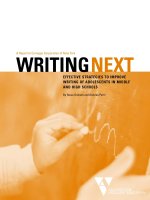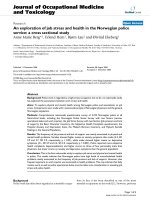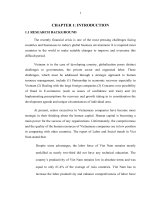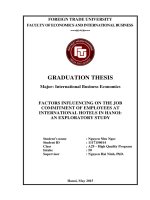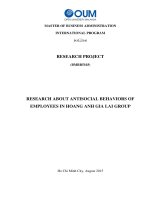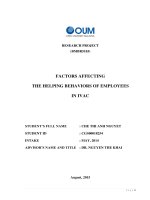Influential factors to job stress of employees in refrigeration electrical engineering corporation (REE)
Bạn đang xem bản rút gọn của tài liệu. Xem và tải ngay bản đầy đủ của tài liệu tại đây (1.7 MB, 55 trang )
RESEARCH PROJECT
(BMBR5103)
INFLUENTIAL FACTORS TO JOB STRESS OF
EMPLOYEES IN REFRIGERATION ELECTRICAL
ENGINEERING CORPORATION (REE)
STUDENT’S FULL NAME
: HO QUANG MINH
STUDENT ID
: CGS00018253
INTAKE
: MAY 2014
ADVISOR’S NAME & TITLE
: DR. NGUYEN THE KHAI (DBA)
August, 2015
ADVISOR’S ASSESSMENT
............................................................................................................................................
............................................................................................................................................
............................................................................................................................................
............................................................................................................................................
............................................................................................................................................
............................................................................................................................................
............................................................................................................................................
............................................................................................................................................
............................................................................................................................................
............................................................................................................................................
............................................................................................................................................
............................................................................................................................................
............................................................................................................................................
............................................................................................................................................
............................................................................................................................................
............................................................................................................................................
............................................................................................................................................
............................................................................................................................................
Advisor’s signature
Nguyen The Khai, DBA
RESEARCH PROJECT
TABLE OF CONTENTS
ABSTRACT ........................................................................................................................5
CHAPTER I: INTRODUCTION .....................................................................................6
I. INTRODUCTION OF REE CORPORATION .......................................................6
Overview of the company ................................................................................................6
I.1
Products and brand name .....................................................................................7
I.2
Organization Structure .........................................................................................8
I.3
Business Objectives .............................................................................................9
I.4
REE Corporation commitments to employees and human resource manager .....9
II. RESEARCH INTRODUCTION ...........................................................................11
II.1
Problem statement..............................................................................................11
II.2
Main construct ...................................................................................................11
II.3
Research objective .............................................................................................11
II.3.1 Research questions .............................................................................................12
CHARPTER II: LITERATURE REVIEW ..................................................................13
I. STRESS IN THE WORKPLACE..............................................................................13
II. DEFINING JOB STRESS.........................................................................................13
III. CAUSES OF JOB STRESS ......................................................................................14
IV. SOURCES OF JOB STRESS ....................................................................................15
CHARPTER III: RESEARCH MODEL AND HYPOTHESES .....................................18
I. RESEARCH MODEL ...........................................................................................18
I.1
Dependent Variables: .........................................................................................18
I.2
Independent Variables: ......................................................................................19
II. CONSTRUCTS .....................................................................................................19
III.
RESEARCH HYPOTHESES ............................................................................19
III.1 Job Overload: .....................................................................................................19
Hypothesis 2: Job overload is positively related with job stress. .........................20
III.2 Role Overload: ...................................................................................................20
Hypothesis 2: Role overload is positively related with job stress. ........................21
III.3 Perceived Injustice: ............................................................................................21
The Elements of Fairness ........................................................................................21
Hypothesis 3: Perceived Injustice is positively related with job stress. ...............22
III.4 Work-Family conflict: .......................................................................................22
Hypothesis 4: Work-Family Conflict is positively related with job stress. .........22
CHARPTER IV: RESEARCH METHODS AND DATA ANALYSIS ......................23
I. RESEARCH DESIGN ...........................................................................................23
II. RESEARCH METHODS ......................................................................................23
II.1
Data collection method ......................................................................................23
II.2
Measures ............................................................................................................23
HO QUANG MINH
2
RESEARCH PROJECT
II.2.1
Job Overload: .................................................................................................23
II.2.2
Role Overload ................................................................................................25
II.2.3
Perceived Injustice .........................................................................................26
II.2.4
Work-Family Conflict....................................................................................27
II.2.5
Job Stress Scale:.............................................................................................29
III.
DATA ANALYSIS AND REPORT..................................................................30
III.1
Reliability Analysis ........................................................................................32
III.2
Descriptive Analysis .......................................................................................33
III.3
Correlation among available...........................................................................33
III.4
Hypothesis Testing .........................................................................................34
CHARPTER V: DISCUSSION AND CONCLUSIONS ..............................................36
I.
SUMARY OF RESULT: ......................................................................................36
II. DISCUSSION AND RECOMMENTDATION....................................................36
III. LIMITATION OF THE STUDY..........................................................................38
IV. CONCLUSIONS ...................................................................................................38
REFERENCES.................................................................................................................40
APPENDIX .......................................................................................................................46
HO QUANG MINH
3
RESEARCH PROJECT
LIST OF TABLE
Table 1: Reliability Statistic of Cronbach’s Alpha ...........................................................32
Table 2: Descriptive Statistics ..........................................................................................33
Table 3: The Pearson’s Correlation .................................................................................33
Table 4: Model Summary .................................................................................................35
Table 5: Coefficientsa .......................................................................................................35
HO QUANG MINH
4
RESEARCH PROJECT
ABSTRACT
Work stress is increasingly becoming a serious problem in the workplace.
Employees in companies frequently trouble, crises and conflicts in the current
working environment in offices and factories that require them to deal with. The
central theme of this research is focused on finding out the underlying causes of the
job stress of employees. This study used quantitative methods using questionnaire
method. Some of the procedures adopted for the implementation of rigorous
quantitative analysis. These organizations can help reduce the overall impact of
work stress by developing and implementing preventive measures and interventions
to help employees manage and cope with job stress. The research is focused on
analyzing the relationship between job overload and job stress; role overload and
job stress; perceived injustice and job stress; work-family conflict and job stress.
The theoretical framework of this study by collecting data were tested from 300
employees of REE Corporation and to assess the factors affecting the Job stress in
the organization.
Key words: job stress, job overload, role overload, perceived injustice, work-family
conflict.
HO QUANG MINH
5
RESEARCH PROJECT
CHAPTER I: INTRODUCTION
I would like to introduce a research about “Influential Factors to Job Stress of
Employees in REE Corporation (Refrigeration Electrical Engineering
Corporation)”.
I. INTRODUCTION OF REE CORPORATION
Overview of the company
Established since 1977, REE (Refrigeration Electrical Engineering Corporation)
today is a diversified business group operating in the fields of mechanical and
electrical engineering services (M&E); manufacturing, assembling and sales of airconditioner systems; real estate development and management; and strategic
investment in the utilities infrastructure sectors.
As one of the first companies to list its shares on the Ho Chi Minh City Stock
Exchange, REE is among the 30 largest companies in term of market capitalization
(as of 31/12/2014, REE's market capitalization is US$ 354 million). REE is among
the most actively traded shares with an average daily volume of 1,297,774 shares in
2014.
History
1977-1999: Building foundation and embracing change
In 1977, the Company was established on the basis of a state entity which
later changed its name into Refrigeration Electrical Engineering Company.
In 1993, REE was one of the first companies to be equitized, paving the way
to enhance the Company’s competitiveness.
In 1996, the Company introduced its first Reetech products.
In 1997, REE was the first company to issue convertible bonds to foreign
investors.
2000-2010: Going public and becoming a diversified business group
In 2000, REE became the first company to be listed on Vietnam’s stock
market.
HO QUANG MINH
6
RESEARCH PROJECT
In 2002-2003, the Company structured the manufacturing and mechanical
and electrical engineering activities into REE M&E and REE Electric
Appliances to grow the businesses stronger.
In 2008, REE’s E.Town campus came into full operation with a total leasable
area of 80,000m2, marking the Company’s entry into real estate
development.
In 2010, REE expanded investments into infrastructure sectors of electricity
and water, looking to meet such basic social needs.
2011-2015: Progressing toward sustainable growth
In 2011, REE continued to expand the office lease space portfolio and
increase investment ownership in infrastructure sectors.
In 2012, the Company issued a convertible bond of 557 billion dong to
Platinum Victory Pte. Ltd., a 100% owned subsidiary of Jardine Cycle
& Carriage Limited – a leading Singapore-listed company and a
member of the Jardine Matheson group, raising capital for investments in
infrastructure sectors and forging a partnership between REE and Jardines to
carry out the Company’s business strategy.
In 2012-2015, REE is focused on achieving a return on equity (ROE) of at
least 15% per annum for this period
I.1 Products and brand name
The Group businesses include:
REE M&E, a leading mechanical and electrical engineering contractor in
Vietnam;
REE Electrical Appliances which manufactures, assembles, and markets air
conditioners under the Reetech brand;
REE Real Estate, a management services company for lease office
properties of REE;
REE Land, a real estate developer; and
HO QUANG MINH
7
RESEARCH PROJECT
Power and Water Utility Infrastructures with ownership stakes in power
utilities and clean water treatment plants.
I.2 Organization Structure
HO QUANG MINH
8
RESEARCH PROJECT
I.3 Business Objectives
Vision:
To become a holding company that invests in and develops leading businesses in
the fields of refrigeration electrical engineering, real estate and utilities
infrastructures in Vietnam.
Mission:
For our Shareholders and Investors: Create the highest values for our
shareholders, commit to transparency in the appropriate disclosures of the
Company’s operations to our shareholders and investors and actively
engage in promoting dialogues with our investors.
For our Customers: Provide our customers with products of high quality,
reliability, and durability; listen and strengthen our technical expertise to
serve our customers’ demands in the best way possible.
For our Business Partners: Maintain and develop long-lasting relationships
with our business partners on the basis of mutual benefits and the creation of
quality products for our society.
For our Community and Society: REE considers as its corporate social
responsibility to have compassion and provide financial supports to our
community and society, particularly in the education, well-being and
development of our children.
For our Employees: Recognize the contribution of our employees and create a
friendly working environment, encourage and respect independent and
creative ideas contributed by our employees for the development of the
Company.
I.4 REE Corporation commitments to employees and human resource
manager
REE is focused on developing and retaining people across all the businesses they
operate in.
Developing People
HO QUANG MINH
9
RESEARCH PROJECT
REE recognizes people as the greatest asset of any business and provides our people
with training and development programs for further growth of their capability and
contribution to the Group. Regular development workshops were conducted for
mid-level managers in various areas such as finance, operation and marketing to
introduce a complete knowledge base for a thorough understanding of different
aspects of each Group business. The Group also has a program to identify and
develop talents through the rotation of their assignments with various corporate
functions and to build up their potential for
leadership roles across Group businesses.
HO QUANG MINH
10
RESEARCH PROJECT
II. RESEARCH INTRODUCTION
II.1
Problem statement
REE are always interested and well implemented on Human resource strategy, the
managers of REE Corporation always want their employees are in good condition to
ensure the highest performance, they think the environment good working, good
treatment from the company, a stable income, the staff are always comfortable and
contribute their best to the company.
Reality does not happen like that, people are always under pressure from other
factors such as family, peers relationships, the role of the present work, fairness in
work, the pressure more from work, etc. Their staff led to the situation that Job
stress, which negatively affects the work efficiency of the individual happens stress
and affect the stages involved in the process. To ensure that the proper
implementing incentive measures aimed at improving employee job performance,
REE Corporation have a better understanding of factors affecting the Job Stress and
how to reduce these effects.
Concerning this issue, the study was conducted to examine the factors that affect the
employee's Job stress.
II.2
Main construct
According to the HR department and production, in recent times many of REE
Corporation personnel were reduced job performance and unusually large impact on
the manufacturing process and the related processes, reduces efficiency overall
performance of the company.
II.3
Research objective
This study mainly seeks to achieve the following objectives:
1. To find out the factors that may impacts on Job stress.
2. To identify the factors that may impact on Job Stress.
3. To suggest some solutions based on research findings to reduce the Job
Stress.
HO QUANG MINH
11
RESEARCH PROJECT
II.3.1 Research questions
Based on the discussion above, and to accomplish the objective of this study, these
research questions have been formulated:
1. How is the impact Job Overload on Job Stress?
2. How is the impact Role overload on Job Stress?
3. How is the impact Perceived injustice on Job Stress?
4. How is the impact Work-Family conflict on Job Stress?
HO QUANG MINH
12
RESEARCH PROJECT
CHARPTER II: LITERATURE REVIEW
I. STRESS IN THE WORKPLACE
Over the past decade many parts of society have been in economic upheaval. Layoffs, downsizing, and bankruptcies have cost millions of people their jobs. Millions more live in constant
fear of the same fate. Many people have accepted pay cuts, and one employee may be
assigned the tasks formerly performed by two or three. People are working longer and
harder just to maintain their economic status.
The result of all these changes? Many research studies have now confirmed that workplace
stress is, and it has been escalating during the last several decades. (Wolever, RQ, Bobinet,
KG. J Occup Health Psychol 2012, The American Institute of Stress)
In a 2007, nationwide poll by the American Psychological Association, more than half of
those surveyed indicated that their work productivity suffered due to stress; almost half stated
that they did not use their allotted vacation time and even considered looking for a new job
because of stress.
Job stress is a concern for employers, costing increase through absenteeism, diminished
productivity, employee turnover, medical, legal, and insurance fees. Health care expenditures
are nearly 50 percent greater for workers who report high levels of stress, according to the
Journal of Occupational and Environmental Medicine. More than half of respondents said
that job demands interfered with family and home. (Wolever, RQ, Bobinet, KG. J Occup
Health Psychol 2012)
II. DEFINING JOB STRESS
The NIOSH defines job stress as the harmful physical and emotional responses that occur
when the requirements of the job do not match the capabilities, resources, or needs of the
worker. It can lead to illness and injury. (American Psychology Association)
The concept of job stress is often confused with challenge, but the concepts are not the same.
Challenge is energizing, physically and psychologically. It motivates people to learn new
skills and master their jobs. When the challenge is met, there is a feeling of satisfaction that is
HO QUANG MINH
13
RESEARCH PROJECT
important to healthy and productive work. Often people are referring to challenge when they
say, “a little bit of stress is good for you.” (The American Institute of Stress)
III. CAUSES OF JOB STRESS
There is general agreement that job stress results from the interaction of the worker and the
conditions of work. There are differing opinions about the importance of worker
characteristics versus working conditions as the primary cause of job stress. The distinction is
important because they will respond to different methods to lessen and prevent stress at work.
Some believe that differences in individuals, such as personality and coping skills, are most
important in predicting whether certain job conditions will result in stress. What is stressful for
one person may not be bothersome to someone else. This belief suggests that prevention
methods should focus on workers and ways to help them cope with demanding job
conditions. (Wolever, RQ, Bobinet, KG. J Occup Health Psychol, 2012)
Individual differences are important, but scientific evidence also suggests that certain working
conditions are stressful to most people. The most stressful work conditions are those in which
workers have a sense of powerlessness, in a situation of extreme demands. (Gadinger, MC,
Schilling, O, Litaker, D, Fisher, JE, 2012)
Based on experience and research, NIOSH’s view is that exposure to stressful working
conditions (job stressors) have a direct influence on worker safety and health, but individual
and other situational factors can intervene to strengthen or weaken this influence. Some
individual and situational factors that can reduce the effects of stressful working conditions
include: balance between work and family or personal life, a support network of friends and
coworkers, and a relaxed and positive outlook. (The National Institute for Occupational
Safety and Health)
Job conditions that may lead to stress include:
Design of tasks – Heavy workload, infrequent breaks, long work hours and
shiftwork, hectic and routine tasks with little inherent meaning, lack of skills needed,
and little sense of control
Management style – Lack of participation by workers in decision-making, poor
communication in the organization, lack of family-friendly policies
HO QUANG MINH
14
RESEARCH PROJECT
Interpersonal relationships – Poor social environment and lack of support or help
from coworkers and supervisors
Work roles – Conflicting or uncertain job expectations, too much responsibility, too
many “hats to wear”
Career concerns – Job insecurity and lack of opportunity for growth, advancement,
or promotion; rapid changes for which workers are unprepared
Environmental concerns – Unpleasant or dangerous physical conditions such as
crowding, noise, air pollution, or ergonomic conditions
IV. SOURCES OF JOB STRESS
Rollinson (2005: 270) defines workplace stress as the conditions arising from the interaction
of people and their jobs, which are characterized by changes within people that force them to
deviate from their normal functioning. Stressors in the workplace are those conditions that
have the potential to result in a person’s experiencing a situation as stressful. The degree of
stress experienced and the ways in which a person reacts to it can be influenced by a number
of other factors such as personal characteristics, lifestyle, social support, appraisal of the
stressor(s), life events and socio-demographic and occupational variables (Rollinson 2005).
Research has indicated the following as the most common sources of job stress that could be
expected to have a measure of impact on organizational activity and employees’ sense of
wellbeing and engagement in the workplace (Cartwright & Cooper 2002; Coetzer &
Rothmann 2007; De Bruin & Taylor 2006; Labuschagne et al. 2005; Martin 2005; Rollinson
2005):
Role ambiguity: This aspect relates to the amount of stress experienced by an
individual due to vague specifications or constant change regarding the performance
expectations, duties, responsibility and constraints that define the individual’s job.
Work relationships: Poor or unsupportive relationships with colleagues and/or line
managers, isolation (a perceived lack of adequate relationships) and unfair treatment
can all be a potential source of stress.
Tools and equipment: To perform their job effectively, individuals need to feel they
have the appropriate training, resources and equipment.
HO QUANG MINH
15
RESEARCH PROJECT
Career advancement: This aspect refers to the stress experienced by individuals as a
result of a perceived lack of opportunity to further their career prospects within the
organization for which they work.
Job security: Job insecurity is an overall concern of losing one’s job or the
discontinuation of one’s job. Job insecurity also implies uncertainty about the future.
Lack of job autonomy: The experience of stress is strongly linked to perceptions of
decision-making authority and control. This may be due to either job constraints or
workplace constraints. When there is great interdependence between the person’s
tasks and the tasks of others, the person is likely to experience stress.
Work–home interface: The demands of work have the potential to spill over and
interfere with individuals’ personal and home lives. This can put a strain on
relationships outside work and impact upon the level of stress, especially when the
individual experiences a perceived lack of social support at home or from friends.
Workload: This aspect refers to the amount of stress experienced by individuals due to
the perception that they are unable to cope or be productive with the amount of work
allocated to them. When people are expected to do more than the time and resources
available permit them to do, they are likely to experience strain.
Compensation and benefits: The financial rewards that work brings are obviously
important because they determine the type of lifestyle that an individual can lead. In
addition, they often influence individuals’ feelings of self-worth and perceptions of
their value to the organization.
Lack of leader/manager support: A supportive work setting is necessary to alleviate
the effects of stress in the workplace. Employees need both tangible and emotional
support, including trust and confidence, guidance, recognition, feedback and active
interest from the immediate manager.
Aspects of the job: The fundamental nature of the job could cause stress. This includes
factors such as physical working conditions, lack of challenging and meaningful
assignments, type of tasks, and amount of satisfaction derived from the job itself.
HO QUANG MINH
16
RESEARCH PROJECT
Nelson (2003) reports a survey which indicates that 41% of people cite workload issues as the
biggest source of stress, with another 31% reporting people or relationship issues and 28%
juggling work and personal life. Research has also indicated that experiencing high levels of
stress may lead to feelings of anger, anxiety, depression, nervousness, irritability, tension,
hypersensitivity to criticism and mental blocks (Cartwright & Cooper 2002; Martin 2005).
This may lead to lower job performance, resentment of supervision, boredom, low selfesteem, inability to concentrate and make decisions, apathy, short attention span, burnout and
job dissatisfaction. Research has also indicated a relationship between stress and absenteeism
and between stress and labor turnover (Coetzer & Rothmann 2007; Mostert, Rothmann,
Mostert & Nell 2008).
HO QUANG MINH
17
RESEARCH PROJECT
CHARPTER III: RESEARCH MODEL AND HYPOTHESES
The primary goal of this study is to investigate the effects of job overload, role
overload, perceived injustice, and work-family conflict to employee job stress in
REE Corporation. The methodology specifically described the research model, the
research instrument, the research hypothesis, data collection process, and the
procedure for the data analysis.
I. RESEARCH MODEL
From theories and previous research results, we propose Hypothesized Research
Model as below:
Job Overload
Role Overload
H1+
H2+
H3+
Job Stress
Perceived Injustice
H4+
Work-Family Conflict
Figure 1: Proposed Research Model of Employee Job Stress in REE Corporation
I.1 Dependent Variables:
-
Job Stress
HO QUANG MINH
18
RESEARCH PROJECT
I.2 Independent Variables:
-
Job Overload
-
Role Overload
-
Perceived Injustice
-
Work-Family conflict
II. CONSTRUCTS
-
Key construct: Job Stress (JS)
-
Other constructs:
Job Overload (JO)
Role Overload (RO)
Perceived Injustice (PI)
Work-Family Conflict (WFC)
III. RESEARCH HYPOTHESES
III.1 Job Overload:
Job overload has been researched and found in relation with work-family conflict
(Bolino & Turnley, 2005; Coverman, 1989; Razak, Yunus, & Nasurdin, 2011).
Similarly, job overload also results in role conflit (Coverman, 1989; Home, 1998).
Most of the research on JO has been conducted by psychologists and social
scientests has linked JO with job stress. According to published studies JO
increases level of stress in an employee and results in turnover (Bakker, Demerouti,
& Verbeke, 2004; Coverman, 1989; Madu, Okoro, & Onuibe, 2014; Maslach,
2003). Furthermore, some studies also associated JO with justice (Andrews,
Wilmington, & Kacmar, 2014; Lambert, Hogan, & Griffin, 2007). Moreover, it has
also been negatively associated with employees’ performance and ultimately with
organization performance (Choi, Cheong, & Feinberg, 2012; Jamal, 2011;
Karatepe., 2013).
Job overload has been positively related with working hours, absenteeism and
competitiveness, size of the firm, turnover etc. and has been negatively associated
HO QUANG MINH
19
RESEARCH PROJECT
with satisfaction and commitment (Dwyer & Ganster, 1991). It has negative effect
on employees attitude and satisfaction (Sargent & Terry, 1998).
Hypothesis 2: Job overload is positively related with job stress.
III.2 Role Overload:
Welbourne, Johnson, and Erez (1998) proposed that individuals in organizations
enact two key work roles: the job-holder role and the organizational-member role.
The job-holder role is representative of the formally prescribed (or in-role) duties
and responsibilities that employees must fulfill; in contrast, the organizational
member role encompasses employee expectations to be good organizational
citizens. Welbourne et al. demonstrated the empirical distinctiveness of these two
work roles, and recent research has suggested that employees often feel pressure to
engage in both types of roles (Perlow, 1998). Moreover, individuals who
successfully fulfill both their job-holder and organizational-member roles are likely
to be given higher performance appraisal ratings and be considered more
promotable than are employees who either choose not to or fail to do so (Allen &
Rush, 1998; Werner, 1994).
Role overload describes situations in which employees feel that there are too many
responsibilities or activities expected of them in light of the time available, their
abilities, and other constraints (Rizzo, House, & Lirtzman, 1970). Logically, then,
fulfilling the organizational member role (while also filling the job-holder role) is
likely to require additional resources on the part of employees, particularly in terms
of their time and energy. Employees may thus find it rather overwhelming to fulfill
their organizational-member role by demonstrating individual initiative—bringing
things home to work on, staying at work after normal business hours, working on
their days off, attending work-related functions on their personal time, and so
forth—when they already struggle to find the time and resources needed to
satisfactorily complete their in-role responsibilities.
A great deal of research has sought to better understand the nature of job stress
(Ganster and Schaubroeck, 1991). Although there has been some debate as to the
HO QUANG MINH
20
RESEARCH PROJECT
specific definition of stress, most researchers generally agree that it is “an
unpleasant emotional experience associated with elements of fear, dread, anxiety,
irritation, annoyance, anger, sadness, grief, and depression” (Motowidlo, Packard,
& Manning, 1986, p. 618). A key element of role theory is the idea that fulfilling
multiple roles is likely to be associated with higher levels of stress and strain.
Hypothesis 2: Role overload is positively related with job stress.
III.3 Perceived Injustice:
People have an inherent need for fairness. In the workplace, perceived injustice has
been directly linked to burnout and job dissatisfaction (Ybema, J.F, 2008). The
challenge for HR arises from the fact that one employee’s fairness often becomes
another employee’s perceived injustice. For example, policies designed to address
the cumulative effects of systemic injustice over many years may be seen as
“special treatment,” triggering feelings of unfairness in other employees today.
Various forms of accommodation, whether required by law or preferred by
management, can sow the seeds of discontent and create rifts between groups of
employees—all in the name of fairness. Everything from work scheduling to
bonuses or office space allocation can be seen as unfair by employees when
mismanaged.
The Elements of Fairness
When it comes to treating employees fairly, three main concepts of fairness come
into play ( Perista, H. and Quintal, E, 2010):
-
Procedural fairness: including procedures used in salary increases, disciplinary
systems, performance evaluation, recruitment and selection. The most
significant contributors to high perceived procedural fairness are transparency
(everyone knows the rules/system), and consistent application (everyone is
subject to the same rules/system).
-
Distributive
fairness:
fair
distribution
of
compensation,
rewards
and
consequences such as wages, evaluations, disciplinary processes, profit-sharing,
HO QUANG MINH
21
RESEARCH PROJECT
promotions and the acceptance or rejection of candidates. To achieve a high
level of distributive fairness, a balance must be achieved among four competing
principles: need, generosity, equality and equity:
Need - those who need more of a benefit should get more than those who
need it less.
Generosity - one person’s outcome should not exceed the outcomes
achieved by others.
Equality - everyone in a group should share its benefits equally.
Equity - the distribution of benefits is tied to people’s relative
contribution (i.e. those who have contributed more should receive more
than those who have contributed less.) (Welsh, N.A)
-
Interactional fairness: this third concept of fairness, which is most often
integrated within the two described above, refers to the way managers and other
decision makers interact with employees. If reasonable and logical explanations
are provided for decisions, and everyone involved is treated with respect and
dignity, a high degree of interactional fairness can be achieved. (Pollack, P.
Fairness)
Hypothesis 3: Perceived Injustice is positively related with job stress.
III.4 Work-Family conflict:
Although the job-holder and organizational-member roles are two important roles,
researchers also recognize that non-work roles (e.g., spouse, family, leisure) are an
integral part of employees’ lives too (e.g., Allen, 2000; Kabanoff, 1980). Work–
family conflict is a specific type of role conflict in which work-role demands
interfere with family-role demands (Greenhaus & Beutell, 1985). Again, role theory
suggests that as employees do more and more for their companies, they are likely to
have less time and energy to devote to their spousal and family responsibilities
(Hochschild, 1997).
Hypothesis 4: Work-Family Conflict is positively related with job stress.
HO QUANG MINH
22
RESEARCH PROJECT
CHARPTER IV: RESEARCH METHODS AND DATA
ANALYSIS
I. RESEARCH DESIGN
Type of research: causal research (the aim of this research is to determine the
cause and effect relationship between variables).
Type of design: questionnaire.
Unit of analysis: individual (an employee).
II. RESEARCH METHODS
II.1 Data collection method
In this study, data was collected using a structured questionnaire which consisted of
39 items. The permission from head of department was set before distributing the
questionnaires. Questionnaires were be translated into Vietnamese to achieve the
accurate information. Data was be collected by questionnaires survey with nonmanagerial employees and managerial employees in all over 5 member companies
of REE Corporation. Questionnaires were sent personally to 450 employees in the
Head Office and in the manufacturing, there are 279 questionnaires were returned.
II.2 Measures
To ensure the research is conducted effectively, the detail of the procedures of
obtaining information is needed in conducting the study in order to solve the
problem. The sampling survey method was primarily used to obtain the information
need for the purpose of the study. The questionnaire was divided to study the
characteristics of the important variables in identifying the relationship between job
overload, role overload, perceived injustice, work-family conflict and job stress.
II.2.1 Job Overload:
Description
This measure, developed by Caplan, Cobb, French, Van Harrison, and Pinneau
(1980), uses 11 items to describe an employee’s job overload. This! focuses on the
HO QUANG MINH
23
RESEARCH PROJECT
employee’s perceptions of quantitative job overload (rather! than mental strain or
psychological pressure). It asks for description of the perceived pace and amount of
work.
Reliability
Coefficient alpha values ranged from .72 to .81 (Dwyer & Ganster, 1991; Phelan,
Bromet, Schwartz, Dew, & Curtis? 1993; Sargent & Terry, 1998; Wallace, 1997).
Validity
Job overload correlated positively with hours worked, competitiveness, firm size,
and absenteeism and correlated negatively with work satisfaction, job satisfaction,
and professional commitment (Dwyer & Ganster, 1991; Phelan j et al., 1993;
Sargent & Terry, 1998; Wallace, 1997).
Source
Caplan, R. D., Cobb, S., French, J. R. P., Van Harrison, R., & Pinneau, S. R.
(1980). Job demands and worker health. Ann Arbor: University of Michigan,
Institute for Social Research. Items were taken from Appendix E, pp. 238-239.
Copyright © 1980. Reproduced with permission.
Items
Responses for items 1 to 4 are obtained on a 5-point Likert-type scale where 1 =
rarely, 2 = occasionally, 3 = sometimes, 4 - fairly often, and 5 = very often.
1.
How often does your job require you to work very fast?
2.
How often does your job require you to work very hard?
3.
How often does your job leave you with little time to get things done?
4.
How often is there a great deal to be done?
Responses for items 5 to 11 are obtained on a 5-point Likert-type scale where 1 =
hardly any, 2 = a little, 3 = some, 4 -a lot, and 5 = a great deal.
5.
How much slowdown in the workload do you experience?
6.
How much time do you have to think and contemplate?
7.
How much workload do you have?
8.
What quantity of work do others expect you to do?
HO QUANG MINH
24

